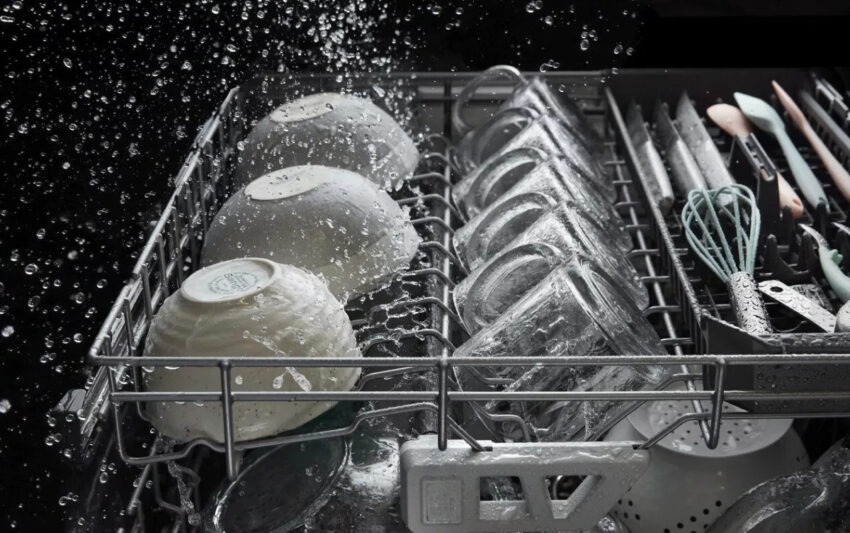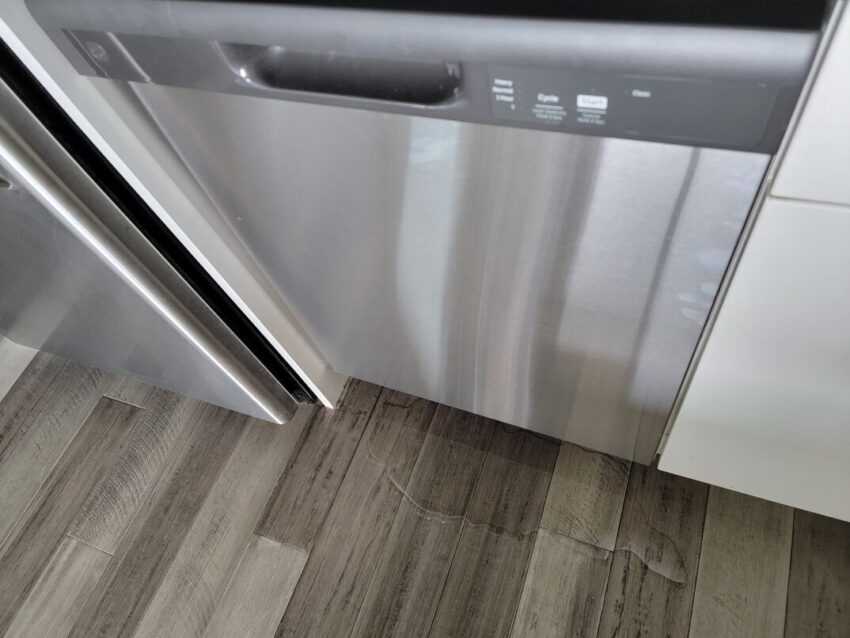If you’ve ever discovered water pooling on your kitchen floor or noticed dampness around your dishwasher, you may be wondering why your dishwasher is leaking from the bottom even when it’s not running. A dishwasher leaking from the bottom when not running can be a frustrating problem to deal with, as it can lead to water damage and potential mold growth if not addressed promptly. In this article, we will explore the possible causes of a dishwasher leaking from the bottom when not in use and discuss practical solutions to resolve this issue.
Understanding Dishwasher Components

Before delving into the reasons behind a dishwasher leaking from the bottom, it’s essential to familiarize yourself with the main components of the appliance. A typical dishwasher consists of a tub, a door seal, a water inlet valve, a drain hose, a pump and motor assembly, and various hose connections. Each of these components plays a vital role in the proper functioning of the dishwasher and can contribute to leaks if they become faulty or damaged. In some cases, a dishwasher leaking into basement can be caused by issues such as a cracked tub, a worn-out door seal, a faulty water inlet valve, a clogged or damaged drain hose, or a malfunctioning pump and motor assembly. It’s important to inspect and address these components if you notice a leak, as it can lead to water damage and other issues in your basement.
Possible Causes of a Leaking Dishwasher
1. Faulty Door Seal
The door seal, also known as the gasket, is responsible for creating a watertight seal between the dishwasher tub and the door. Over time, the door seal can degrade or become loose, leading to water leakage. Inspect the door seal for any signs of damage, such as cracks or gaps. If you notice any issues, replacing the door seal may be necessary.
2. Defective Water Inlet Valve
The water inlet valve controls the flow of water into the dishwasher during the cleaning cycle. If the inlet valve malfunctions or develops a defect, it can result in water continuously entering the dishwasher, causing leakage. A faulty water inlet valve may require replacement to resolve the issue.
3. Clogged or Damaged Drain Hose
The drain hose is responsible for carrying the wastewater out of the dishwasher and into the sink or garbage disposal. If the drain hose becomes clogged or damaged, water can back up and leak from the bottom of the dishwasher. Inspect the drain hose for any blockages or visible signs of damage, and clean or replace it as needed.
4. Malfunctioning Pump or Motor
The pump and motor assembly in a dishwasher work together to circulate water and remove debris during the cleaning process. If either of these components malfunctions, it can lead to water leakage. A professional technician may need to diagnose and repair the pump or motor to fix the issue.
5. Loose or Damaged Hose Connections
The hose connections that link various parts of the dishwasher can loosen over time or become damaged, resulting in leaks. Inspect all hose connections, such as those between the water inlet valve, pump, drain hose, and tub, ensuring they are securely attached. If any connections are loose or damaged, tighten or replace them accordingly.
6. Improper Dishwasher Installation
An improperly installed dishwasher can lead to various issues, including leaks. Ensure that your dishwasher is installed correctly, with the necessary water supply and drain connections securely in place. If you suspect installation issues, consult the manufacturer’s instructions or seek professional assistance.
7. Excessive Detergent Usage
Using an excessive amount of dishwasher detergent can lead to overflows and leaks. Follow the manufacturer’s recommendations regarding detergent usage to prevent such issues. Using too much detergent can also cause additional problems like residue buildup and poor cleaning performance.
8. Cracked or Damaged Tub
A cracked or damaged dishwasher tub can be a significant cause of leakage. Inspect the interior of the dishwasher tub for any visible cracks or damage. If you discover any, it may be necessary to replace the tub to resolve the problem effectively.
9. Dishwasher Overloading
Overloading the dishwasher with too many dishes can obstruct the spray arms and prevent proper drainage. This can result in water collecting at the bottom and leaking out. Ensure that you load the dishwasher according to the manufacturer’s guidelines to allow proper water circulation and drainage.
10. High Water Pressure
If your home has excessively high water pressure, it can put additional stress on the dishwasher’s components, leading to leaks. Consider installing a pressure regulator to stabilize the water pressure and protect your dishwasher from potential damage.
11. Hard Water Buildup
Hard water contains mineral deposits that can accumulate inside the dishwasher’s components over time. These deposits can obstruct the water flow, damage seals, and contribute to leaks. Regularly clean your dishwasher and consider using water-softening techniques or products to minimize the effects of hard water.
Troubleshooting and Fixing a Leaking Dishwasher
Now that you have an understanding of the possible causes of a dishwasher leaking from the bottom, let’s explore some troubleshooting steps and potential solutions to address this issue.
1. Check the Door Seal
Start by inspecting the door seal for any signs of damage or misalignment. Clean the seal and ensure it is properly seated against the tub. If you notice any cracks, gaps, or loose seals, consider replacing them with a new one.
2. Inspect the Water Inlet Valve
Carefully examine the water inlet valve for any leaks or defects. If you notice water continuously entering the dishwasher even when it’s not running, the water inlet valve may need to be replaced. Consult the dishwasher’s user manual or seek professional help to handle this repair.
3. Examine the Drain Hose
Inspect the drain hose for any blockages or damage that may be causing water to back up and leak. Remove any debris or obstructions and ensure the hose is properly connected to the sink or garbage disposal. If the drain hose is damaged, replace it with a new one.
4. Assess the Pump and Motor
If you suspect a malfunctioning pump or motor, it’s best to seek professional assistance. A technician will be able to diagnose the problem accurately and perform any necessary repairs or replacements.
5. Tighten or Replace Hose Connections
Check all hose connections within the dishwasher to ensure they are tightly secured. If you notice any loose or damaged connections, tighten them or replace the hoses if necessary. Properly sealed hose connections are crucial for preventing leaks.
6. Verify Proper Dishwasher Installation
If you suspect that the dishwasher was not installed correctly, consult the manufacturer’s instructions or seek professional help to ensure proper installation. Correcting any installation issues can help eliminate potential sources of leakage.
7. Adjust Detergent Usage
Review the detergent usage guidelines provided by the dishwasher manufacturer. Use the recommended amount of detergent to prevent excessive suds and overflows. Avoid using more detergent than necessary, as it can lead to leaks and other problems.
8. Inspect the Tub for Cracks
Thoroughly examine the dishwasher tub for any visible cracks or damage. If you find any, it may be necessary to replace the tub to resolve the issue effectively. Contact the manufacturer or a professional technician to discuss the best course of action.
9. Avoid Overloading the Dishwasher
Follow the dishwasher’s loading instructions to prevent overloading. Overfilling the dishwasher can obstruct water flow and drainage, leading to leaks. Ensure there is enough space for proper water circulation and efficient cleaning.
10. Install a Pressure Regulator
Consider installing a pressure regulator if your home has high water pressure. A pressure regulator helps maintain consistent water pressure, protecting your dishwasher from potential leaks and damage caused by excessive pressure.
11. Address Hard Water Issues
If you live in an area with hard water, regularly clean your dishwasher and consider using water-softening techniques or products. These measures can help minimize the buildup of mineral deposits and reduce the chances of leaks.
Conclusion
Dealing with a dishwasher leaking from the bottom when not running can be a frustrating experience. By understanding the potential causes of this issue and following the troubleshooting steps outlined in this article, you can diagnose and resolve the problem effectively. Remember to address any damaged components, ensure proper installation, and practice proper dishwasher maintenance to prevent future leaks and extend the lifespan of your appliance.
You may like to read How to Drain a Pool

